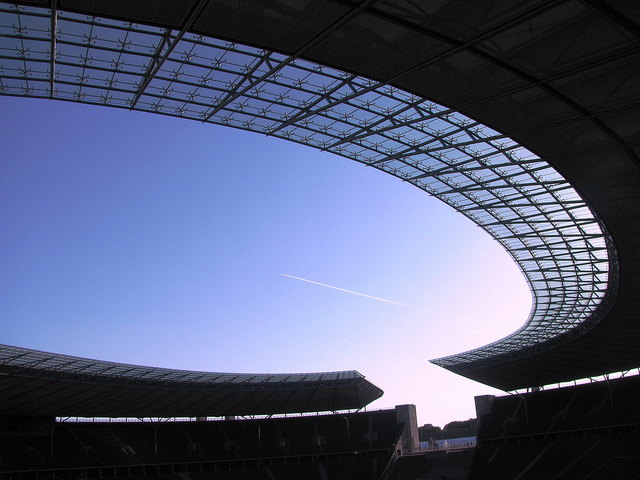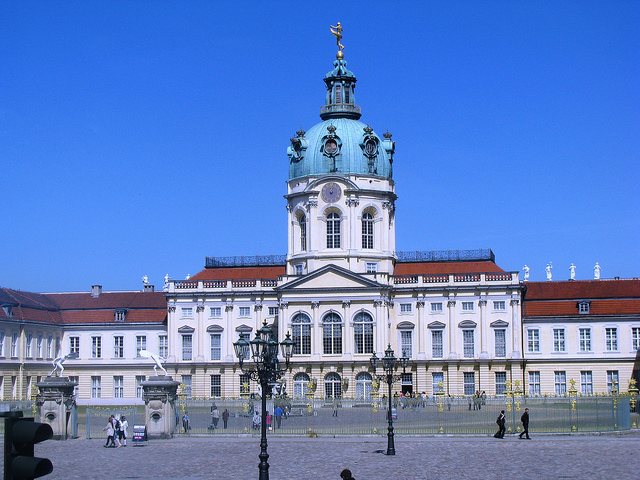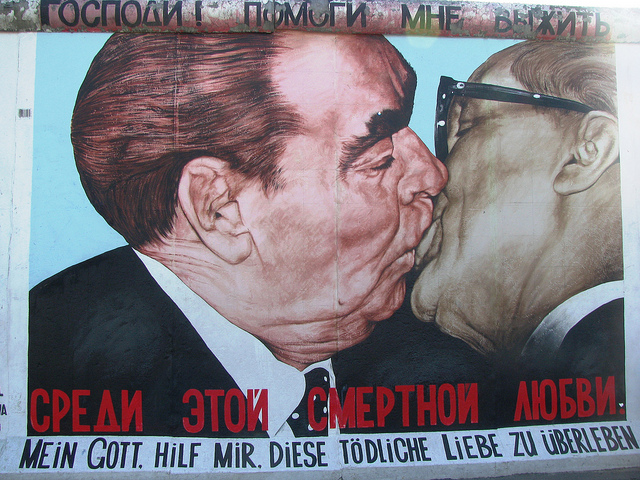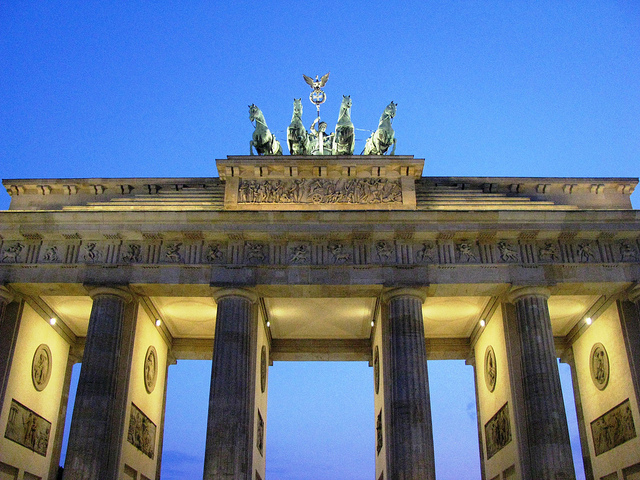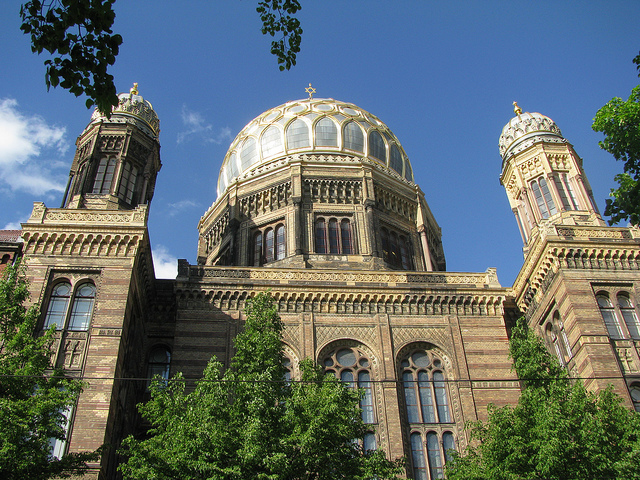Now that I had a great overview of Berlin’s most important sights, I decided to head a bit farther afield and explore one of Berlin’s outlying areas: Spandau, formerly an independent town, is Berlin’s westernmost district and easily reachable on the S7 S-Bahn line. I arrived in the mid-afternoon in brilliant sunshine and admired the flower market that was set up on the square in front of the train station. The imposing city hall, built between 1910 and 1913, stood on the other side of a busy street, and the entrance into the old part of Spandau was just ahead.

The town was relatively quiet on this Saturday afternoon, but it was clear that it must have been market day. A few vegetable stores still had stands set up on the street and were selling colourful fruits and veggies. There was an amusement area set up for children who were still having fun, jumping on a big trampoline, securely strapped into a harness. I made my way towards the river where I got a good look at some old warehouses on the other side. Spandau, of course, has a long and interesting history. It was first mentioned in historic records as early as 1232 AD.
Much of Spandau’s old town has actually been rebuilt after WW II. Given that Spandau was the location of some weapons factories during the Second World War, a good portion of Spandau was destroyed in bombing raids. Another infamous part of Spandau’s history is the Spandau Prison which held some of the worst Nazi war criminals after the Nuremberg Trials in 1946. Its most famous inmates include Albert Speer, Hitler’s architect and later the Nazi Minister of Armaments and War Production, as well as Rudolf Hess, the Deputy Führer. After Hess died in 1987, the prison was closed and demolished in 1987 in order to ensure that it would not be turned into a Neo-Nazi shrine.

From the riverfront I continued my stroll towards one of the town’s most famous structures: the Spandau Citadel. This fortress was built between 1559 and 1594 on top of an earlier fortification. It was besieged by the Swedes in 1675, and Napoleon conquered it in 1806. During this attack the fortress was almost completely destroyed and had to be extensively restored.
The World War II history of the Spandau Citadel is much darker: it was used as a research laboratory for nerve gas from 1935 onwards. Today the fortress is a museum that features archaeological remains of an 11th century Slavic settlement, Jewish gravestones from the 13th to the 15th century, and a history museum that is located in the citadel’s armoury. An outdoor area holds a collection of 32 life-size sculptures of historic personalities that are awaiting an exhibition scheduled to start in 2013. Nowadays, the Citadel hosts many special events, from Easter markets to medieval knight spectacles to a bat festival and many more.
Today, the theme was “Walpurgisnacht” (Walpurgis Night) – a traditional spring time festival that is usually celebrated on April 30 or May 1 and named after Saint Walburga. In Germany, this festival is associated with witches who are awaiting the arrival of spring. The entire Spandau Citadel was decked out in a witches theme and many costumed interpreters dressed up as witches were mingling with the crowd. A just-married couple was driving up in a horse-drawn carriage to have their wedding pictures taken at this picturesque fortress.

On the way back from the citadel I stopped at the Nikolai-Kirche (St. Nicholas Church) which was built in the 15th century in the location of an earlier church. Then it was back on the S-Bahn to my next stop: the Olympic Stadium. Opened in 1936 for the Berlin Olympic Games, this is still Germany’s second largest stadium today. It escaped the war mostly unscathed and its impressive scale and austere design still speak to the monumental architectural styles employed by the totalitarian regimes of the 1930s. Today it is the home of the Hertha Berlin football team which plays in the German Bundesliga.
It was now almost 6 pm and the Olympic area was just about to close. Hardly any visitors were there, and looking down the long exterior corridors with their limestone columns and their black torches sent shivers down my spine, to think that this very stadium was used during the Third Reich for propagandist purposes. This is the place where Leni Riefenstahl, the talented yet controversial German film maker, filmed “Olympia”, whose footage of the 1936 Olympics glorified the Nazi ideology. In this movie, Riefenstahl introduced many amazing film-making innovations such as extreme close-ups, slow motion and camera shots taken on tracking rails. The film was internationally lauded as an aesthetic masterpiece, but the fact remains that its primary purpose was to venerate Nazi ideology.

The greater than life-size sculptures of muscular athletes on the outside grounds just reinforced the images of the Fascist body cult. I am from Austria myself, and every time I travel to sites that were an integral part of the Third Reich it sends chills down my spine to think of the horrifying events that people from my country instigated and took part in. To think that Hitler, Goebbels or Göring themselves had walked these very grounds is quite a frightening thought. Not surprisingly, a trip to Berlin has many such experiences in store…
For the evening program, I had planned to explore Germany’s more recent past in greater detail: with thousands of exhibits that can be touched and examined first-hand, the DDR Museum (GDR Museum) illustrates daily life in the former East Germany. The German Democratic Republic was a socialist state that was created by the Soviet Union in 1949 on the former Soviet-occupied part of Germany. This totalitarian regime crumbled with the fall of the Berlin Wall and officially ceased to exist in 1990.
Located across the river from the Berlin Cathedral, the DDR Museum opened in 2006 as a private institution and received its 500,000th visitor in 2008. It is now one of the most popular attractions in Berlin and covers many topics: the daily life of East Germans, women and families, transportation, shopping, vacations, culture and leisure. A complete East German kitchen, living room and bathroom illustrate how East Germans lived in the countless concrete highrise buildings that went up after the war. Visitors can even peer into the cupboards.

One of the most popular displays is a Trabant car, the kind of basic vehicle that East German families had to wait for years to get, based on East Germany’s centralized planning economy. Museum visitors can sit down inside the vehicle and inspect it up close. The tangible aspects of the exhibits in the DDR Museum are an absolute hit with the visitors.
Of course the museum also showcases the more sinister facets of the former East German regime. You will see exhibits about media, ideology, correctional services and the authorities. A prison cell and interrogation room have also been reconstructed and secret listening devices used by the Stasi, East Germany’s secret police, are on display as well. A Volvo sedan, part of the East Germany ministerial vehicle fleet, is also on display. The DDR Museum provides a tangible illustration of so many aspects of life in the former German Democratic Republic.
It had been a very full day of historic explorations, and back at my hotel the images that I had taken in during the day continued to make me think for quite a while….
